
USP Class VI approved one and two component adhesives, sealants and coatings are formulated for the assembly of medical devices. These specialty compounds are designed to adhere to dissimilar substrates, resist exposure to sterilization and for easy application.
Key Advantages of Master Bond's Biocompatible Compounds
Medical grade adhesives, sealants, coatings and potting/encapsulation compounds need to be non-toxic and show compatibility with blood and body fluids. Additionally, they must be biologically inert. There are two standard tests used to determine their suitability: U.S. Pharmacopeia (USP) Class VI and/or ISO 10993. Master Bond offers biocompatible compounds, which meet one or both specifications.
General Comparison of Different Chemistries for Medical Device Adhesives
| Epoxies | Silicones | 1-part | 2-part | 1-part | 2-part |
|---|---|---|---|---|
| Applications | Bonding, coating, sealing and potting |
Bonding, coating, sealing and potting |
Bonding, coating, and sealing | Bonding, coating, sealing and potting |
| Typical Service Temperature Range |
4K to 400°F | 4K to 400°F | -75°F to 400°F | -65°F to 400°F |
| Curing Requirements |
Fast cures at elevated temperatures | Room/heat curing systems | Room temperature (moisture) curing | Room/heat (addition) curing systems |
| Key Properties | Structural, with good temperature resistance and easy processing | Excellent chemical resistance, with very good physical strength profile | High degree of flexibility with no mixing needed | Excellent flexibility, and cures in thick sections with low stress imparted |
| UV/LED Curing Systems | Epoxy-Polyurethane Blends | Cyanoacrylates | |
|---|---|---|---|
| Applications | Bonding, coating, sealing and encapsulation | Bonding, coating, sealing and potting | Bonding, coating, and sealing |
| Typical Service Temperature Range | -60°F to 400°F | 4K to 250°F | -60°F to 250°F |
| Curing Requirements | Light curing systems (-365 nm to 405 nm) Dual curing with heat | Room/heat curing systems | Room temperature curing systems |
| Key Properties | Quick cure times, along with good optical as well as physical strength characteristics | Good degree of toughness, combining flexibility with good overall physical strength properties | Good bond strength capability with quick cures for smaller components |
| Epoxies | Silicones | UV/LED Curing Systems | Epoxy-Polyurethane Blends | Cyanoacrylates | |
|---|---|---|---|---|---|
| Metals | Excellent | Good | Good | Good | Excellent |
| Plastics | Excellent | Fair | Very Good | Fair | Very Good |
| Glass | Very Good | Good | Very Good | Good | Very Good |
| Rubbers | Very Good | Fair | Fair | Good | Good |
| Epoxies | Silicones | UV/LED Curing Systems | Epoxy-Polyurethane Blends | Cyanoacrylates | |
|---|---|---|---|---|---|
| Repeated Autoclaving | Excellent | Poor | Very Good | Poor | Poor |
| Repeated Chemical Sterilization (Sterrad®) | Excellent | Poor | Very Good | Poor | Poor |
| Gamma, E-beam, EtO etc. | Excellent | Excellent | Excellent | Very Good | Good |
All systems can be applied manually, semi-automatically and automatically.
Sterrad® is a registered trademark of Johnson & Johnson.
Find out more about our full product line of USP Class VI approved adhesive systems.
Find out more about our products meeting ISO 10993-5 cytotoxicity requirement.
Most Popular USP Class VI Approved Products
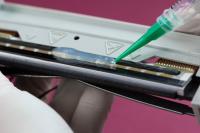 |
MasterSil 711Med Exceptionally fast setting, high performance, non-corrosive silicone rubber. Used in medical device manufacturing. Has superb flexibility. Servicable from -75°F to +400°F. |
 |
EP42HT-2Med Low viscosity, two part epoxy with outstanding chemical resistance. Passes USP Class VI biocompatibility tests. Capable of withstanding repeated sterilization cycles including radiation, EtO, chemical sterilants, autoclaving. Serviceable from -60°F to +450°F. Cures at room or elevated temperatures. Available in amber-clear and black colors. Castable in thicknesses up to 2-3 inches. |
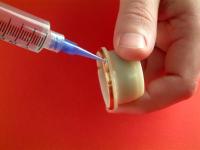 |
EP41SMed Biocompatible. Meets USP Class VI test specification. Impressive resistance to chemical sterilants including ethylene oxide, bleach, glutaraldehyde, hydrogen peroxide based systems and paracetic acid type compounds. High bond strength. Electrical insulator. Fast curing. Quick handling time. Service temperature range -60°F to +250°F. |
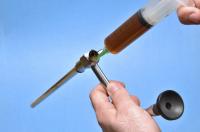 |
EP62-1Med Two part epoxy requiring moderate heat curing (80-120°C). Meets USP Class VI biocompatibility specifications. Superb resistance to repeated autoclaving along with excellent adhesion to high temperature plastics such as Ultem, PEEK, etc. Exceptionally long working life. Outstanding electrical insulation properties. Serviceable from -60°F to +450°F. |
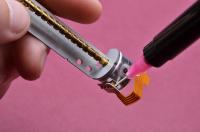 |
LED403Med One part, high viscosity system. Cures tack-free without any oxygen inhibition. Meets USP Class VI specifications; also passes ISO 10993-5 cytotoxicity test. Resists gamma radiation, EtO and various chemical sterilants. Serviceable from -60°F to +250°F. |
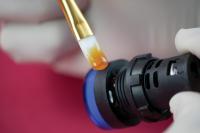 |
EP62-1HTMed Superior sterilization resistance. Two part epoxy has long pot life at ambient temperatures. High bond strength properties. Ideal for bonding and coating. Good flow. Reliable electrical insulator. Serviceable from -60°F to +450°F. Tg 150-155°C. Shore D hardness 80-90. |
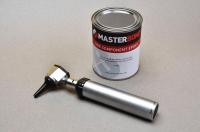 |
EP3HTND-2Med Black Rapid curing, one part epoxy. Meets USP Class VI biocompatibility standards. Non-drip, paste viscosity. High shear strength. Superb resistance to autoclaving, chemical sterilants, radition, EtO. Serviceable from -60°F to +400°F. |
